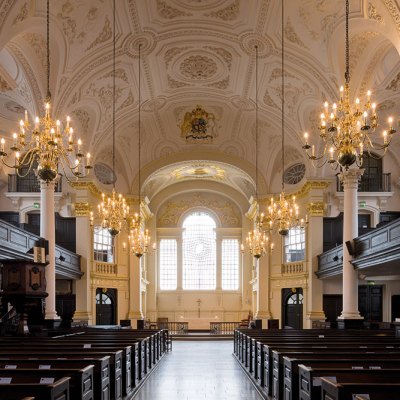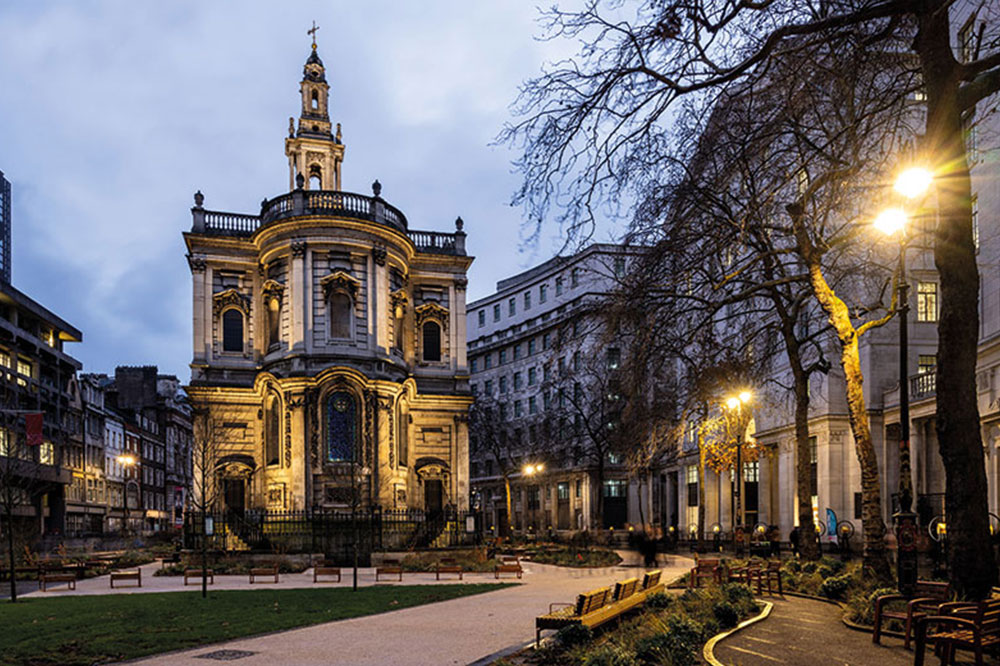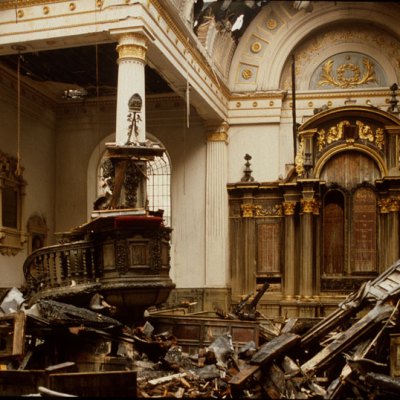
From the May 2023 issue of Apollo. Preview and subscribe here.
The Church of St Mary-le-Strand was once known to London bus drivers as ‘St Mary’s in the Way’. Standing in the middle of the Strand, a congested artery between Westminster and the City of London, the church was long seen by motorists and urban planners alike as little more than an obstruction. Over the three centuries since its consecration in 1724, the road surrounding the church was gradually widened, taking great bites out of the churchyard and threatening to devour the church itself. Threats to the church only seemed to grow. John Betjeman’s last poem was written as part of a campaign to protect it. In 2017, it seemed its luck had finally run out. With the congregation in single digits, the Church of England prepared to sell it off to become a UK outpost of the Museum of the Bible (in Washington, D.C.). Stripped of furniture and fittings, it would have been little more than an empty shell.
This would have been a travesty. For the church, particularly its interior, is one of London’s architectural glories. It was designed by the Scottish-born architect James Gibbs (1682–1754), his first public commission after his return from Rome, where he had trained in the studio of Carlo Fontana. For an untested young architect, the prominently sited church provided an unrivalled opportunity. He was awarded it as part of his work as Surveyor for the Commission for Fifty New Churches, a body established in 1710 as a monument both to Queen Anne and to the High Church, High Tory ascendancy of her final years. Beginning as the queen’s health deteriorated, the Commissioners knew that they had only limited time to execute their plans. Indeed, when Anne died in 1714, the incoming Hanoverian royal family and its sober Whig ministry quickly wound down the Commission. Only 12 of 50 projected churches were built.
Those that were built, however – the others were designed by Nicholas Hawksmoor and Thomas Archer – are among the outstanding examples of English architecture of any period. With the Commission eager to make an impression quickly, budgets were almost unlimited. Gibbs seized the chance to show off everything he had learned in Italy. He did not quite have carte blanche, having inherited the foundations of an earlier project by Archer. His initial role had been to design a 250-foot-high monumental column to Queen Anne to stand in front of the church; when she died, however, the commissioners quickly dropped the column and focused their energies on the church, which Gibbs designed, taking on some of Archer’s ideas.
In his executed design, Gibbs decided to make the same point as the monumental column but more subtly. He took his cues from St Paul’s Cathedral – completed in 1711 after nearly half a century of work – showing the sophistication of his Italian training by reworking Christopher Wren’s ideas in a new context. The semi-circular projections of the west and east elevations were inspired, respectively, by the north porch and east end of St Paul’s and, inside, the disposition of the east end closely matches Wren’s design. The ornamental quality of the design is created by Gibbs’s ingenious compression of motifs deriving from St Paul’s into a much smaller area.
When built, the church was always expected to be in the centre of London’s life and traffic – in A Book of Architecture (1728), Gibbs explained that he had inserted windows only in the upper storey of the north and south elevations, with niches below, ‘to keep out Noises from the Street’. Of all the churches projected by the commission, St Mary-le-Strand was perhaps the most prominently situated, a point not lost on its architect; he explained elsewhere that ‘the Building can not be too fine for the situation, since it’s so much in viue.’ As envisaged, it was to have been a major monument on the royal processional route into the City of London, something obscured by the comparative unpopularity of the early Hanoverians, under whom it was finished, and their dislike of public processions.
Since last year, the church’s urban context, so important to its design and history, has been completely transformed. Gone are the streams of traffic that smothered it on either side, replaced by raised beds and picnic benches, part of a scheme to unite the campuses of three of London’s universities, King’s College, the London School of Economics and the Courtauld Institute, into a single ‘Global Cultural Thinking Quarter’. Once an inconvenience, the church is now hailed as the ‘jewel in the Strand’, the focus of London’s newest piazza. The project is not yet totally successful. The zigzagging benches in the supposedly Italianate piazza have a strange, playground quality, and the aims of the and the aims of the Global Cultural Thinking Quarter seem ill-defined. Yet, visiting a year on, a once unappealing – and dangerous – thoroughfare is populated with people, loitering, taking in their surroundings and visiting the church.
With St Mary’s at last protected from the engine fumes that have for so long blackened and corroded its exterior stonework, and from the developer’s wrecking ball that threatened it in the 19th century, it is now possible to look towards preserving the fabric for future generations. One major ambition is to make the raised ground floor accessible and also turn the crypt (intended for burials) into usable space for events and church activities. On such a cramped site, the project will undoubtedly be challenging. Above ground, the church hopes to restore original features and relight the space to show its magnificent plasterwork ceiling to better advantage. The interior fittings, though the result of several reworkings, retain important original elements. To help achieve this, the church has been awarded a grant of £3.9 million by the National Lottery Heritage Fund, and is currently fundraising for the additional £4.5 million needed for its ambitious plans.
In 1716, as work on the church continued, Gibbs’s former patron John Erskine, Earl of Mar, wrote to the architect from exile in France (Erskine was a Jacobite). It was, he thought, Gibbs’s ‘fair daughter in the Strand […] the most complete little damsel in town’. If done right, the restoration now being planned may bring this church to completion once more.
From the May 2023 issue of Apollo. Preview and subscribe here.


